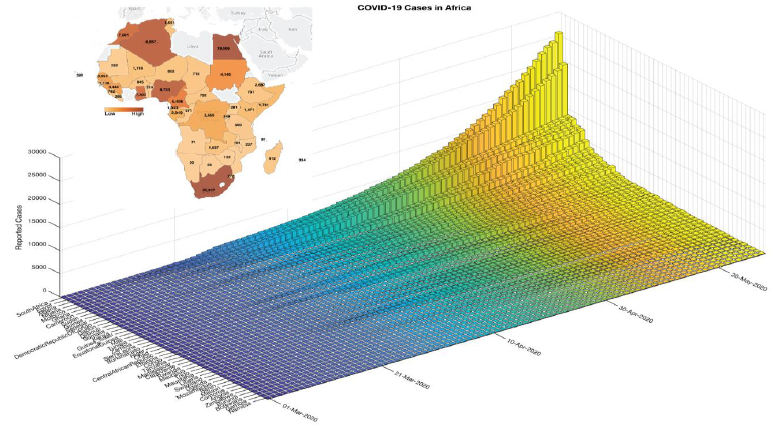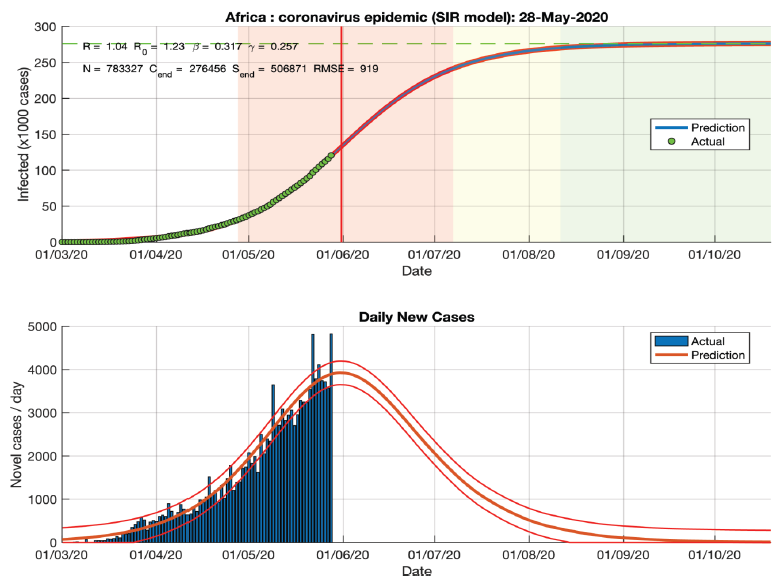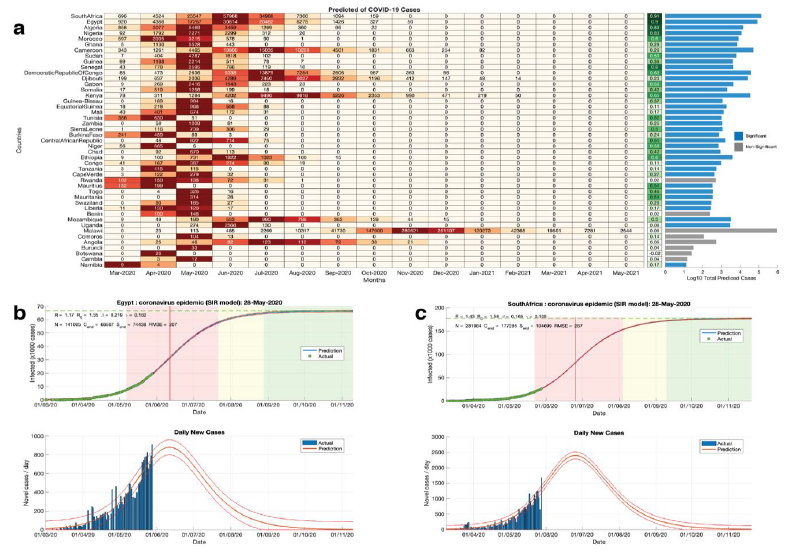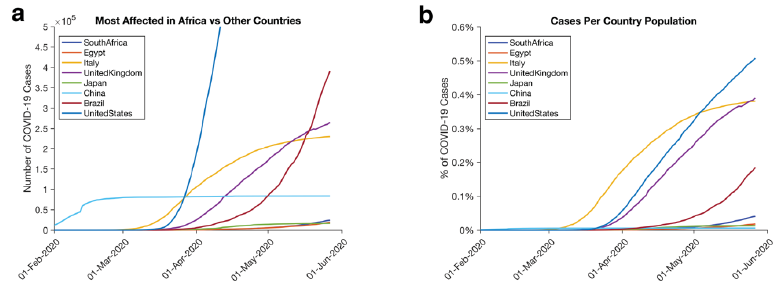The COVID-19 Pandemic in Africa: Predictions using the SIR Model
Article Information
Musalula Sinkala*, 1, 2, Panji Nkhoma1, Mildred Zulu3, Doris Kafita1, Rabecca Tembo3, Victor Daka4
1University of Zambia, School of Health Sciences, Department of Biomedical Sciences, P.O. Box 50110, Nationalist Road, Lusaka, Zambia.
2University of Cape Town, Faculty of Health Sciences, Institute of Infectious Disease and Molecular Medicine, Computational Biology Division, Anzio Rd, Observatory, 7925, Cape Town, South Africa.
3University of Zambia, School of Medicine, Department of Pathology and Microbiology, P.O. Box 50110, Nationalist Road, Lusaka, Zambia.
4Copperbelt University, School of Medicine, Ndola, Zambia.
*Corresponding author: Musalula Sinkala, University of Zambia, School of Health Sciences, Department of Biomedical Sciences, P.O. Box 50110, Nationalist Road, Lusaka, Zambia.
Received: 25 September 2021; Accepted: 05 October 2021; Published: 14 October 2021
Citation: Musalula Sinkala, Panji Nkhoma, Mildred Zulu, Doris Kafita, Rabecca Tembo, Victor Daka. The COVID-19 Pandemic in Africa: Predictions using the SIR Model. Fortune Journal of Health Sciences 4 (2021): 491-499.
View / Download Pdf Share at FacebookAbstract
Since the earliest reports of the Coronavirus disease - 2019 (COVID-19) in Wuhan, China in December 2019, the disease has rapidly spread worldwide, attaining pandemic levels in early March 2020. However, the spread of COVID-19 has differed in the African setting compared to countries on other continents. To predict the spread of COVID-19 in Africa and within each country on the continent, we applied a Susceptible-Infectious-Recovered mathematical model. Here, our results show that, overall, Africa is currently (May 29, 2020) at the peak of the COVID-19 pandemic, after which we predict the number of cases would begin to fall in June 2020. Furthermore, we predict that the ending phase of the pandemic would be in Mid-August 2020 and that decreasing cases of COVID-19 infections would be detected until around December 2020 and January 2021. Our results also reveal that of the 51 countries with reported COVID-19 cases, only nine, including South Africa, Egypt and Ethiopia, are likely to report higher monthly COVID-19 cases in June 2020 than those reported in the previous months. Overall, at the end of this pandemic, we predict that approximately 279,000 (about 154,000 future cases) individuals in Africa would have been infected with the COVID-19 virus. Here, our predictions are data-driven and based on the previously observed trends in the spread of the COVID-19 pandemic. Shifts in the population dynamics and/or changes in the infectiousness of the COVID-19 virus may require new forecasts of the disease spread.
Keywords
COVID-19; COVID-19 in Africa; SIR model; Disease prediction; COVID-19 modelling
COVID-19 articles; COVID-19 in Africa articles; SIR model articles; Disease prediction articles; COVID-19 modelling articles, COVID-19 articles COVID-19 Research articles COVID-19 review articles COVID-19 PubMed articles COVID-19 PubMed Central articles COVID-19 2023 articles COVID-19 2024 articles COVID-19 Scopus articles COVID-19 impact factor journals COVID-19 Scopus journals COVID-19 PubMed journals COVID-19 medical journals COVID-19 free journals COVID-19 best journals COVID-19 top journals COVID-19 free medical journals COVID-19 famous journals COVID-19 Google Scholar indexed journals COVID-19 in Africa articles COVID-19 in Africa Research articles COVID-19 in Africa review articles COVID-19 in Africa PubMed articles COVID-19 in Africa PubMed Central articles COVID-19 in Africa 2023 articles COVID-19 in Africa 2024 articles COVID-19 in Africa Scopus articles COVID-19 in Africa impact factor journals COVID-19 in Africa Scopus journals COVID-19 in Africa PubMed journals COVID-19 in Africa medical journals COVID-19 in Africa free journals COVID-19 in Africa best journals COVID-19 in Africa top journals COVID-19 in Africa free medical journals COVID-19 in Africa famous journals COVID-19 in Africa Google Scholar indexed journals SIR model articles SIR model Research articles SIR model review articles SIR model PubMed articles SIR model PubMed Central articles SIR model 2023 articles SIR model 2024 articles SIR model Scopus articles SIR model impact factor journals SIR model Scopus journals SIR model PubMed journals SIR model medical journals SIR model free journals SIR model best journals SIR model top journals SIR model free medical journals SIR model famous journals SIR model Google Scholar indexed journals Disease prediction articles Disease prediction Research articles Disease prediction review articles Disease prediction PubMed articles Disease prediction PubMed Central articles Disease prediction 2023 articles Disease prediction 2024 articles Disease prediction Scopus articles Disease prediction impact factor journals Disease prediction Scopus journals Disease prediction PubMed journals Disease prediction medical journals Disease prediction free journals Disease prediction best journals Disease prediction top journals Disease prediction free medical journals Disease prediction famous journals Disease prediction Google Scholar indexed journals COVID-19 modelling articles COVID-19 modelling Research articles COVID-19 modelling review articles COVID-19 modelling PubMed articles COVID-19 modelling PubMed Central articles COVID-19 modelling 2023 articles COVID-19 modelling 2024 articles COVID-19 modelling Scopus articles COVID-19 modelling impact factor journals COVID-19 modelling Scopus journals COVID-19 modelling PubMed journals COVID-19 modelling medical journals COVID-19 modelling free journals COVID-19 modelling best journals COVID-19 modelling top journals COVID-19 modelling free medical journals COVID-19 modelling famous journals COVID-19 modelling Google Scholar indexed journals susceptible-infected-removed articles susceptible-infected-removed Research articles susceptible-infected-removed review articles susceptible-infected-removed PubMed articles susceptible-infected-removed PubMed Central articles susceptible-infected-removed 2023 articles susceptible-infected-removed 2024 articles susceptible-infected-removed Scopus articles susceptible-infected-removed impact factor journals susceptible-infected-removed Scopus journals susceptible-infected-removed PubMed journals susceptible-infected-removed medical journals susceptible-infected-removed free journals susceptible-infected-removed best journals susceptible-infected-removed top journals susceptible-infected-removed free medical journals susceptible-infected-removed famous journals susceptible-infected-removed Google Scholar indexed journals MATLAB articles MATLAB Research articles MATLAB review articles MATLAB PubMed articles MATLAB PubMed Central articles MATLAB 2023 articles MATLAB 2024 articles MATLAB Scopus articles MATLAB impact factor journals MATLAB Scopus journals MATLAB PubMed journals MATLAB medical journals MATLAB free journals MATLAB best journals MATLAB top journals MATLAB free medical journals MATLAB famous journals MATLAB Google Scholar indexed journals
Article Details
The novel Coronavirus disease-2019 (COVID-19), which was first reported in China in December 2019, has quickly spread to become a global pandemic [1–3]. As of 29th May2020, over 6.1 million people have tested positive for COVID-19 [4]. So far, global infections of the virus have been unevenly distributed across continents and countries; Europe, North America and South America are among the most impacted. Despite more than 125,000 cases reported in Africa, the spread of COVID 19 has been surprisingly slow and the disease has exhibited lower-case fatality rates in comparison to other continents [5]. It was expected that the continent, with fragile health systems, barriers to testing, and potentially vulnerable populations, would report high numbers of cases and deaths. Additionally, familiarity with infectious disease outbreaks and diseases leading to an educated immune system has been postulated as possible reasons for these observations [5,6].
Recently, mathematical models have been applied to investigate the spread of COVID-19 pandemic in various countries, among others, China [7], Italy [8], and England [9]. The predictions gleaned from these models have offered a platform for decision making aimed at controlling and/or mitigating the spread of COVID-19 pandemic and the optimisation of lockdowns and treatment efforts [9–11]. However, currently, most of the COVID-19 modelling has been in high-income countries, and very few efforts have been made to model the spread of COVID-19 in many African countries.
Mathematical models that have been employed to predict the spread of the pandemic include logistic models [12,13] and Susceptible-Infected-Recovered (SIR) models [8,14]. In modelling using the SIR approach, we assume that the population is a compartment of interacting individuals in which the disease spread from the infected to the susceptible, and the infected either recover and build an immunity toward the infectious agent or succumb to the infection [15,16]. Here, we use the SIR model to predict the spread of the COVID-19 positive cases on the African continent as a whole and in 45 different countries on the continent. Overall, we provide valuable intuition regarding the expected trajectory of the disease in Africa.
2. Results
2.1 COVID-19 in Africa
We obtained a dataset of the global COVID-19 cases from covid.ourworldindata.org. We found out that, as of May 28, 2020, 51 out of 56 African counties have reported the number of COVID-19 positive cases.
We extracted information on COVID-19 cases in African countries to show that South Africa has reported the highest number of cases (25,937), followed by Egypt (19,666) and Morocco (8,857; Figure 1).

Figure 1: Status of the COVID-19 pandemic in Africa as of 28th May 2020
2.2 Prediction of COVID-19 cases in Africa
We obtained the daily COVID-19 cases in Africa starting March 1, 2020, by aggregating all the reported cases per day for each country in Africa. Then, we utilised the susceptible-infected-removed (SIR) epidemic model to estimate the trajectory of the pandemic in Africa (see Methods Sections). Here, our model has accurately predicted the cases of COVID-19 in Africa with statistical significance (R2 = 0.999, p-value = 5.9 x 10-134; Figure 2). Furthermore, our results showed that, in Africa, the COVID-19 pandemic would be at the turning point on May 31, 2020, get to the steady growth phase around July 7, 2020, and the ending phase will begin around August 11, 2020. Overall, based on the current data and the trajectory of COVID-19 positive cases, we predict that COVID-19 will infect another 153,518 individuals to bring the total number of COVID-19 positive cases to approximately 279,000. Also, we predict that the pandemic would have ended on the dates between December 2020 and January 2021 (for more details, see Supplementary Table 1).

Figure 2: Predicted and actual cases of COVID-19 based on the SIR model as of 28 May 2020.
Table 1: Prediction of COVID-19 spread in Africa by SIR model
|
Parameter |
Statistic |
|
Estimated duration (days) |
|
|
Turning day |
91 |
|
Acceleration phase |
34 days |
|
Deceleration phase |
35 days |
|
Total growth phase duration |
68 days |
|
Total epidemic duration |
312 days |
|
Estimated datums |
|
|
Outbreak |
01-Mar-2020 |
|
Start of acceleration |
27-Apr-2020 |
|
Turning point |
31-May-2020 |
|
Start of steady growth |
05-Jul-2020 |
|
Start of ending phase |
08-Aug-2020 |
|
End of epidemic (5 cases) |
10-Dec-2020 |
|
End of epidemic (1 case) |
07-Jan-2021 |
|
Statistics (total cases) |
|
|
F-statistics vs. zero model |
40659.4 |
|
p-value |
1.12 x 10-132 |
2.3 Prediction of COVID-19 cases for each African country
Next, we used the SIR model to predict the spread of COVID-19, the expected total number infected, and the duration of an epidemic in each African Country. Here, our results showed that, for most countries in Africa, we would expect to see fewer COVID-19 cases from June 2020 than those reported in May 2020 (Figure 3a; see Supplementary File 1 for all predictions, also see the individual plots for each country provided in Supplementary File 2). However, based on the current data and spread of the disease, we predicted that the cases of COVID-19 would likely peak in June 2020 for Egypt (Figure 3b), South Africa (Figure 3c), and Ethiopia. Furthermore, we predict the number of COVID-19 cases in Cameroon, Kenya, and Gabon to peak in July.

Figure 3 (a): Left; heatmap showing the predicted COVID-19 cases per month based on the SIR model for each country in Africa. Middle; correlation (R-square) between the predicted and actual daily COVID-19 across each country. The bar graphs represent the based ten logarithms transformed total numbers of predicted COVID-19 cases from the start to the end of the COVID-19 pandemic. Bars are coloured based on the false discovery rate p-values of the SIR model of each country; blue denotes q-values < 0.05 and grey denotes q-values > 0.05. Predicted and actual cases of COVID-19 based on the SIR model in (b) Egypt and (c) South Africa as of 28 May 2020.
2.4 COVID-19 in most affected African countries versus the rest of the world
We compared the reported COVID-19 positive cases in the most affected countries in Africa (South Africa and Egypt) to those in other countries that have been affected across the globe. Here, we showed that the scale of the COVID-19 cases was lower, even for the worst affected countries in Africa than that in the United States of America, Japan, China, Italy, United Kingdom and Brazil (Figure 4a). This assertion remains valid even when we consider the number of reported COVID-19 cases as a per cent for each of the country's population size (Figure 4b).

Figure 4: Comparison of COVID-19 Cases reported in some of the most affected countries in Africa (South Africa and Egypt) and countries on other continents. (a) Lines show the total number of reported COVID-19 cases. (b) Lines show the percentage of COVID-19 infected individuals for each country.
3. Discussion
We conducted a predictive analysis of the COVID-19 pandemic in Africa. Our results show that the scale of the pandemic is low across many countries in Africa. Many experts have debated the reason why fewer cases of COVID-19 are being reported in Africa. Several hypotheses have been suggested to explain these disparities including the lack of widespread testing of COVID-19 thereby underestimating the disease burden [17–20], sensitivity of the virus to ambient temperature [21,22] and Africa’s relatively young population [23–25].
We showed that, on average, most counties in Africa, including Zimbabwe, Malawi, and Benin, have reported fewer than 500 COVID-19 cases. Conversely, most European countries have reported, on average more than 5000 COVID-19 cases. Importantly, our prediction shows that the number of COVID-19 cases reported in May 2020 is unlikely to be surpassed by those in the next few months. Furthermore, whereas we predicted that the COVID-19 pandemic would disproportionately affect different countries in Africa, we expect that even the worst affected among these would report fewer COVID-19 positive cases compared to other regions of the World.
Altogether, based on the current COVID-19 pandemic data and the spread of disease, our predictions show that the peak pandemic is now (May 29, 2020) for most African countries. Here, we caution that our results are only as good as the data and the previous trend observed in the spread of the COVID-19 pandemic. Hence, these predictions may not be indicative of future trends where certain parameters, such as the population dynamics and COVID-19 virus infectiousness, are shifted from those currently prevailing. Therefore, we encourage everyone (including individuals in African countries) to adhere to the guidelines that are aimed at reducing the spread of the COVID-19 virus as provided by the WHO and other relevant organisations.
4. Methods
We analysed a COVID-19 dataset representing the reported virus-positive cases in the World as of May 29, 2020, obtained from https://covid.ourworldindata.org/data. We extracted the COVID-19 cases reported in 51 African countries and plotted these individually to show the trajectory of the COVID-19 pandemic for each country.
Next, we aggregated all the reported COVID-19 cases in Africa since March 1, 2020. Then we used the Susceptible-Infected-Removed (SIR) mathematical model [15,16] to predict the temporal dynamics of the COVID-19 spread, the expected number of infection cases, and the duration of the pandemic in Africa. Briefly, the principal assumption of the SIR model is that the population, in which the viruses (or other pathogens) spread, is comprised of three subgroups of individuals. Those 1) uninfected and susceptible (S) to infection, 2) those infected (I) and can transmit the infection to the uninfected, and 3) those individuals removed (R) from the infection cycle, either because they recovered from the disease and are immune or succumbed to the disease [10,26,27]. Here, we applied the SIR model implemented in MATLAB [14,28].
Furthermore, we used the SIR model to predict the spread of COVID-19, the expected number of infection cases, and the duration of the pandemic for each country in Africa. Here, we modified the code also to predict the number of COVID-19 infected cases of each country per day (see the Code Availability sections). Briefly, we obtained the predicted number of COVID-19 cases using the SIR model. These predictions include multiple data points per day. Therefore, we aggregated the predictions made at irregular time intervals per day to yield a single prediction for each country per day by interpolation using the Cubic spline algorithm [29,30]. Also, to predict the number of cases of COVID-19 infection of each country, we aggregated the predictions for each month (see Figure 3a).
Data Availability
The data that supports the findings of this study are available at covid.ourworldindata.org.
Code Availability
All the MATLAB source code used to process, analyse, and reproduce the major finding of this report is from the following websites: https://www.mathworks.com/matlabcentral/fileexchange/76435-covid-19-predictions-in-africa-using-the-sir-model
Supplemental Information
Supplementary File 1:
Predict cases of COVID-19 using the SIR model for each day across each country in Africa.
Supplementary File 2:
Plots of the predicted trajectory of the COVID-19 cases of each country in Africa.
Author Contributions
SM, PN, and VD conceptualised the study; The formal methodology was devised by VD, DK, PN, MZ, RT, and MS; VD, DK, PN, RT, and MS performed the formal analysis of the datasets; VD, DK, MZ, RT, and PN wrote the draft manuscript; the manuscript was revised by MS, DK, MZ, RT, VD. MS created visualisations.
Competing interests
The authors declare that they have no competing interests
References
- Roda WC, Varughese MB, Han D, Li MY. Why is it difficult to accurately predict the COVID-19 epidemic? Infect Dis Model 5 (2020): 271–81.
- Zu ZY, Jiang M Di, Xu PP, Chen W, Ni QQ, Lu GM, et al. Coronavirus Disease 2019 (COVID-19): A Perspective from China. Radiology (2020): 200490.
- Batista M. Estimation of the final size of the coronavirus epidemic by the logistic model. MedRxiv 2020:2020.02.16.20023606.
- Coronavirus Update (Live): 6,150,262 Cases and 370,500 Deaths from COVID-19 Virus Pandemic - Worldometer n.d.
- The Lancet. COVID-19: protecting health-care workers. Lancet 395 (2020): 922.
- Munjita SM, Samutela M, Ndashe K, Munsaka SM. Immunity, parasites, genetics and sex hormones: contributors to mild inflammatory responses in COVID-19? PAMJ 2020.
- Peng L, Yang W, Zhang D, Zhuge C, Hong L. Epidemic analysis of COVID-19 in China by dynamical modeling. n.d.
- Calafiore GC, Novara C, Possieri C. A Modified SIR Model for the COVID-19 Contagion in Italy. 2020.
- Danon L, Brooks-Pollock E, Bailey M, Keeling MJ. A spatial model of CoVID-19 transmission in England and Wales: early spread and peak timing. MedRxiv 2020:2020.02.12.20022566.
- Jewell NP, Lewnard JA, Jewell BL. Predictive Mathematical Models of the COVID-19 Pandemic: Underlying Principles and Value of Projections. JAMA - J Am Med Assoc 323 (2020): 1893–4.
- Enserink M, Kupferschmidt K. With COVID-19, modeling takes on life and death importance. Science (80- ) 367 (2020): 1414–5.
- Wu K, Darcet D, Wang Q, Sornette D. Generalized logistic growth modeling of the COVID-19 outbreak in 29 provinces in China and in the rest of the world 2020.
- Batista M. Estimation of the final size of the second phase of the coronavirus COVID 19 epidemic by the logistic model 2020.
- Batista M. (PDF) Estimation of the final size of the coronavirus epidemic by the SIR model. Estim Final Size Coronavirus Epidemic by SIR Model 2020.
- Hethcote HW. The Mathematics of Infectious Diseases 42 (2000).
- Jones JH. Notes On R 0 1 The Basic Reproduction Number in a Nutshell. 2007.
- Agyeman AA, Laar A, Ofori-Asenso R. Will COVID-19 be a litmus test for post-Ebola sub-Saharan Africa? J Med Virol 2020.
- Kobia F, Gitaka J. COVID-19: Are Africa’s diagnostic challenges blunting response effectiveness? AAS Open Res 3 (2020): 4.
- Kavanagh MM, Erondu NA, Tomori O, Dzau VJ, Okiro EA, Maleche A, et al. Access to lifesaving medical resources for African countries: COVID-19 testing and response, ethics, and politics. Lancet (London, England) 395 (2020):1735–8.
- Wells CR, Stearns JK, Lutumba P, Galvani AP. COVID-19 on the African continent. Lancet Infect Dis (2020).
- Hopman J, Allegranzi B, Mehtar S. Managing COVID-19 in Low- and Middle-Income Countries. JAMA - J Am Med Assoc 323 (2020): 1549–50.
- Sajadi MM, Habibzadeh P, Vintzileos A, Shokouhi S, Miralles-Wilhelm F, Amoroso A. Temperature and Latitude Analysis to Predict Potential Spread and Seasonality for COVID-19. SSRN Electron J (2020).
- Dyer O. Covid-19: Africa records over 10 000 cases as lockdowns take hold. BMJ 369 (2020): m1439.
- Martinez-Alvarez M, Jarde A, Usuf E, Brotherton H, Bittaye M, Samateh AL, et al. COVID-19 pandemic in west Africa. Lancet Glob Heal 8 (2020): e631–2.
- Ayebare RR, Flick R, Okware S, Bodo B, Lamorde M. Adoption of COVID-19 triage strategies for low-income settings. Lancet Respir Med8 (2020): e22.
- McCluskey CC. Complete global stability for an SIR epidemic model with delay - Distributed or discrete. Nonlinear Anal Real World Appl 11 (2010): 55–9.
- Satsuma J, Willox R, Ramani A, Grammaticos B, Carstea AS. Extending the SIR epidemic model. Phys A Stat Mech Its Appl 336 (2004): 369–75.
- Batista M. fitVirusCOVID19 - File Exchange - MATLAB Central. FitVirusCOVID19 2020.
- De Boor CR. A Practical Guide to Spline 2014.
- Akima H. A New Method of Interpolation and Smooth Curve Fitting Based on Local Procedures. J ACM 17 (1970): 589–602.
